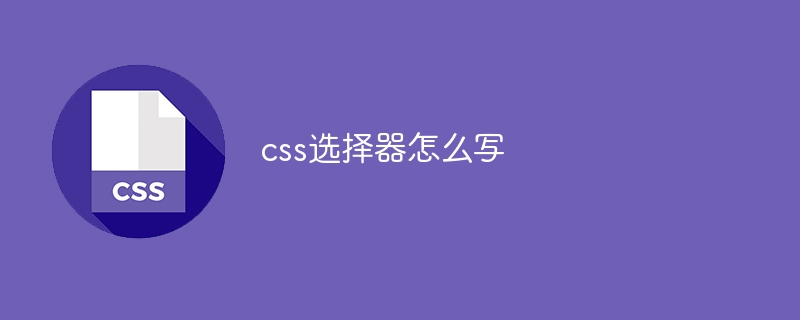How to write css selector
<p>CSS selectors are patterns used to select elements in HTML documents. They include element selectors, class selectors, ID selectors, wildcard selectors, and descendant selectors. The syntax of a selector is selector name, operator, and value. Operators include # (ID selector), . (class selector), and * (wildcard selector). When multiple selectors are applied to the same element, the most specific (longest) selector will take precedence. Advanced selectors include adjacent selectors, child element selectors, pseudo-class selectors, and pseudo-element selectors for more precise element selection.<p>
 <p>CSS Selector Writing Guide
<p>What is a CSS selector?
<p>CSS selectors are patterns used to select specific elements in an HTML document.
<p>Selector type
<p>CSS Selector Writing Guide
<p>What is a CSS selector?
<p>CSS selectors are patterns used to select specific elements in an HTML document.
<p>Selector type
-
Element selector: Select a specific type of element, such as
<div>or<p>. -
Class selector: Selects elements with a specific CSS class name, such as
.my-class. -
ID selector: Select elements with a specific ID attribute, such as
#my-id. -
Wildcard selector:Select all elements, such as
*. -
Descendant selector: Select descendant elements of an ancestor element, such as
div p.
- Selector name: Specify element type or attribute
- Operator: Usually used to specify specific conditions
- Value: Specific value of the selector
-
:- Specify the class selector -
# - Specify the ID selector -
.: Specify the wildcard selector
-
#my-id- Select elements with ID attribute "my-id" -
.my-class- Selects elements with CSS class name "my-class" -
div p- Selects all<div>Descendants of elements<p>Elements -
*- Select all elements
-
Adjacent selector ( ): Selects an element immediately following another After the element, such as
p h1 - ##Child element selector (>): Select the direct child element of an element, such as div > p
- Pseudo-class selector: Select based on the state or behavior of the element, such as :hover
- Pseudo-element selection Selector: Select a specific part of an element, such as ::after
The above is the detailed content of How to write css selector. For more information, please follow other related articles on the PHP Chinese website!

Hot AI Tools

Undresser.AI Undress
AI-powered app for creating realistic nude photos

AI Clothes Remover
Online AI tool for removing clothes from photos.

Undress AI Tool
Undress images for free

Clothoff.io
AI clothes remover

Video Face Swap
Swap faces in any video effortlessly with our completely free AI face swap tool!

Hot Article

Hot Tools

Notepad++7.3.1
Easy-to-use and free code editor

SublimeText3 Chinese version
Chinese version, very easy to use

Zend Studio 13.0.1
Powerful PHP integrated development environment

Dreamweaver CS6
Visual web development tools

SublimeText3 Mac version
God-level code editing software (SublimeText3)

Hot Topics
 1390
1390
 52
52
 How to use bootstrap in vue
Apr 07, 2025 pm 11:33 PM
How to use bootstrap in vue
Apr 07, 2025 pm 11:33 PM
Using Bootstrap in Vue.js is divided into five steps: Install Bootstrap. Import Bootstrap in main.js. Use the Bootstrap component directly in the template. Optional: Custom style. Optional: Use plug-ins.
 The Roles of HTML, CSS, and JavaScript: Core Responsibilities
Apr 08, 2025 pm 07:05 PM
The Roles of HTML, CSS, and JavaScript: Core Responsibilities
Apr 08, 2025 pm 07:05 PM
HTML defines the web structure, CSS is responsible for style and layout, and JavaScript gives dynamic interaction. The three perform their duties in web development and jointly build a colorful website.
 How to write split lines on bootstrap
Apr 07, 2025 pm 03:12 PM
How to write split lines on bootstrap
Apr 07, 2025 pm 03:12 PM
There are two ways to create a Bootstrap split line: using the tag, which creates a horizontal split line. Use the CSS border property to create custom style split lines.
 Understanding HTML, CSS, and JavaScript: A Beginner's Guide
Apr 12, 2025 am 12:02 AM
Understanding HTML, CSS, and JavaScript: A Beginner's Guide
Apr 12, 2025 am 12:02 AM
WebdevelopmentreliesonHTML,CSS,andJavaScript:1)HTMLstructurescontent,2)CSSstylesit,and3)JavaScriptaddsinteractivity,formingthebasisofmodernwebexperiences.
 How to use bootstrap button
Apr 07, 2025 pm 03:09 PM
How to use bootstrap button
Apr 07, 2025 pm 03:09 PM
How to use the Bootstrap button? Introduce Bootstrap CSS to create button elements and add Bootstrap button class to add button text
 How to resize bootstrap
Apr 07, 2025 pm 03:18 PM
How to resize bootstrap
Apr 07, 2025 pm 03:18 PM
To adjust the size of elements in Bootstrap, you can use the dimension class, which includes: adjusting width: .col-, .w-, .mw-adjust height: .h-, .min-h-, .max-h-
 How to set up the framework for bootstrap
Apr 07, 2025 pm 03:27 PM
How to set up the framework for bootstrap
Apr 07, 2025 pm 03:27 PM
To set up the Bootstrap framework, you need to follow these steps: 1. Reference the Bootstrap file via CDN; 2. Download and host the file on your own server; 3. Include the Bootstrap file in HTML; 4. Compile Sass/Less as needed; 5. Import a custom file (optional). Once setup is complete, you can use Bootstrap's grid systems, components, and styles to create responsive websites and applications.
 How to insert pictures on bootstrap
Apr 07, 2025 pm 03:30 PM
How to insert pictures on bootstrap
Apr 07, 2025 pm 03:30 PM
There are several ways to insert images in Bootstrap: insert images directly, using the HTML img tag. With the Bootstrap image component, you can provide responsive images and more styles. Set the image size, use the img-fluid class to make the image adaptable. Set the border, using the img-bordered class. Set the rounded corners and use the img-rounded class. Set the shadow, use the shadow class. Resize and position the image, using CSS style. Using the background image, use the background-image CSS property.




